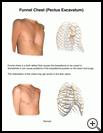
Funnel Chest
________________________________________________________________________
KEY POINTS
- Funnel chest is a birth defect that causes the breastbone to be caved in. Sometimes it can cause problems if the breastbone pushes on the heart and lungs.
- If the sunken chest is causing problems with your child's heart or lungs, your child’s healthcare provider may suggest surgery.
- Follow the treatment plan prescribed by your child's healthcare provider. Ask your child's provider what exercises your child can do to keep a good posture, especially to help with breathing.
________________________________________________________________________
What is funnel chest?
Funnel chest is a birth defect that causes the breastbone to be caved in. Funnel chest usually does not cause any symptoms or complications. Sometimes it can cause problems if the breastbone pushes on the heart and lungs, or it can make the chest severely deformed.
This condition is also called sunken chest or pectus excavatum.
What is the cause?
The exact cause of funnel chest is not known. It may be caused by overgrowth of the tissue that connects the ribs to the breastbone. The abnormal tissue may push the breastbone in.
- Marfan syndrome, which is an inherited disease that weakens the tissue that normally gives strength and support for your body
- Rickets, which is a problem with bone growth caused by a lack of vitamin D or calcium
- Scoliosis, which causes the spine to curve to the right or left rather than run straight down the back
- Mitral valve prolapse, which is a problem with one of the valves that help control blood flow through the heart
- Ehlers Danlos syndrome, which is a rare inherited disease that weakens the tissue between the bones, muscles, and organs
- Osteogenesis imperfecta, which is a rare inherited disease that causes weak bones
- Neuromuscular disease, such as spinal muscular atrophy
What are the symptoms?
The chest curves inward instead of outward and looks sunken. Often it can be seen at birth. The indentation of the chest may get worse in the teen years. It usually stays the same in adulthood.
Other than a sunken breastbone area, most children don’t have symptoms. If the condition is severe, symptoms may include:
- Chest or back pain
- Fast or pounding heartbeat
- Poor ability or difficulty with exercise
- Shortness of breath
- Tiredness
How is it diagnosed?
Your child’s healthcare provider will review your child’s symptoms and medical history and examine your child. Your child may have tests such as:
- Chest X-ray
- CT scan, which uses X-rays and a computer to show detailed pictures of the chest
- ECG (also called an EKG or electrocardiogram), which measures and records the heartbeat
- Echocardiogram, which uses sound waves (ultrasound) to see how well the heart is pumping
- Blood tests
- Exercise tests
- Breathing tests to see how well your child’s lungs are working
How is it treated?
If your child does not have symptoms, your child may not need treatment.
For more severe cases, especially if the sunken chest is causing problems with your child’s heart or lungs, or makes the chest severely deformed, your child’s healthcare provider may suggest surgery. Metal supports may be put inside the chest to raise the breastbone to a more normal position. They are usually removed after about 2 years. Surgery can improve your child’s posture and help the heart and lungs work better.
How can I help take care of my child?
- Follow the treatment plan prescribed by your child’s healthcare provider.
- Ask your child’s healthcare provider:
- What exercises your child can do to keep good posture, especially to help breathing
- If there are activities your child should avoid
- How to take care of your child at home
- What symptoms or problems you should watch for and what to do if your child has them
- Make sure you know when your child should come back for a checkup. Keep all appointments for provider visits or tests.
Last modified: 2019-10-08
Last reviewed: 2019-09-19

